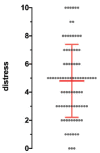Distress in Neuro-Oncology Patients and Its Implications for Communication
- PMID: 37313277
- PMCID: PMC10258858
- DOI: 10.6004/jadpro.2023.14.4.3
Distress in Neuro-Oncology Patients and Its Implications for Communication
Abstract
Psychoemotional distress affects patients with cancer, including patients with a diagnosis of a malignant brain tumor. Empathy, professional expertise, and conversational skills are required to ensure successful communication with patients. The purpose of this study was to assess whether knowing the communication needs of patients would be helpful to neuro-oncologists before meeting with them. Patients in our neuro-oncology center were asked to complete the National Comprehensive Cancer Network Distress Thermometer (DT) and a study-specific questionnaire on patients' expectations for communication with the treating physician. The questions targeted issues such as attention/caring and awareness of their disease and prognosis. Importance ratings were compared between patients, with high vs. low distress scores to analyze the impact of distress on the patient's needs in physician-patient communication. A total of 81 patients completed the DT and questionnaire. One third (n = 27) had IDH wild-type astrocytoma, and 42 patients (51.9%) were undergoing therapy for primary or recurrent disease. Mean distress was 4.88 (standard deviation ± 2.64) in the whole cohort, and 56.8% of patients had a high distress score (≥ 5 on a 10-point scale). All issues were assessed as important or very important for communication by the majority of patients, and importance ratings increased in patients with high distress levels for most items. Mean importance ratings correlated significantly with distress scores (p < .001). Distress was increased in neuro-oncology patients. Patients with higher distress levels considered issues of both attention/caring and medical information about the disease as more important than patients with lower distress levels. Using distress assessment may help physicians and advanced practitioners to tailor the contents of their discussion for successful communication with patients.
© 2023 Harborside™.
Conflict of interest statement
The authors have no conflicts of interest to disclose.
Figures


References
-
- Applebaum, A. J., Buda, K., Kryza-Lacombe, M., Buthorn, J. J., Walker, R., Shaffer, K. M., D'Agostino, T. A., & Diamond, E. L. (2018). Prognostic awareness and communication preferences among caregivers of patients with malignant glioma. Psycho-Oncology, 27(3), 817–823. 10.1002/pon.4581 - DOI - PMC - PubMed
-
- Coomans, M. B., Dirven, L., Aaronson, N. K., Baumert, B. G., Van Den Bent, M., Bottomley, A.,…Taphoorn, M. J. B. (2019). Symptom clusters in newly diagnosed glioma patients: Which symptom clusters are independently associated with functioning and global health status? Neuro-Oncology, 21(11), 1447–1457. 10.1093/neuonc/noz118 - DOI - PMC - PubMed
-
- Hickmann, A.-K., Hechtner, M., Nadji-Ohl, M., Janko, M., Reuter, A. K., Kohlmann, K.,…Renovanz, M. (2017). Evaluating patients for psychosocial distress and supportive care needs based on health-related quality of life in primary brain tumors: A prospective multicenter analysis of patients with gliomas in an outpatient setting. Journal of Neuro-Oncology, 131(1), 135–151. 10.1007/s11060-016-2280-0 - DOI - PubMed
LinkOut - more resources
Full Text Sources
